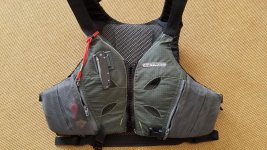Returning to the landing after yet another paddle on my local Patuxent, we encountered a pair of DNR officers in full tactical outfit. They looked like they were SWAT, making me wonder if there was a hostage situation or something. No, they were merely intent on checking our fish catch and sounded unconvinced when we told them we hadn’t done any fishing. They stood on the dock looking in the boat and switched their line of inquiry to three duck decoys, which we explained we had pulled out of a strainer. No fishing, no hunting, nothing to see here, but one officer had an idea, “can we see your whistle?”
I usually carry a whistle in my PFD, but have lately been hiking a lot, and put the whistle in my hiking day pack. I grabbed the whistle out of the pack that morning and threw it in the dry bag with other stuff as I was racing to get out of the house. Facing the officer there at the dock, I had only a vague idea where it was. That’s not useful. A whistle you can’t find when you need it is pretty much useless, except on the one in a thousand chance you run into a DNR officer that wants to see it. As it was, the officer got bored watching me rummage through my large dry bag and told me he’d take my word for it.
I’ve carried that whistle in my PFD for years, but never needed it until that moment at the dock. So, my fellow paddlers, don’t neglect this critical piece of gear! I’m kind of making fun of it, but, like other things we carry and may not often use, when you need it, it can save your life, or at least avoid a citation.
I usually carry a whistle in my PFD, but have lately been hiking a lot, and put the whistle in my hiking day pack. I grabbed the whistle out of the pack that morning and threw it in the dry bag with other stuff as I was racing to get out of the house. Facing the officer there at the dock, I had only a vague idea where it was. That’s not useful. A whistle you can’t find when you need it is pretty much useless, except on the one in a thousand chance you run into a DNR officer that wants to see it. As it was, the officer got bored watching me rummage through my large dry bag and told me he’d take my word for it.
I’ve carried that whistle in my PFD for years, but never needed it until that moment at the dock. So, my fellow paddlers, don’t neglect this critical piece of gear! I’m kind of making fun of it, but, like other things we carry and may not often use, when you need it, it can save your life, or at least avoid a citation.


